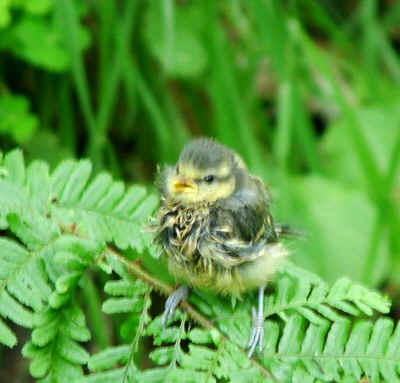
What To Do If You Find a Baby Bird
An Animal Rights Article from All-Creatures.org
FROM
People for the Ethical Treatment of Animals (PETA)
June 2009
This is busy season for wildlife emergencies. One of the most common
calls wildlife centers get this time of year involves the caller stating
that a bird is injured and unable to fly. While this is certainly common,
and we all have the instinct to rush right out and snatch the birdie, it’s
important to make sure that the bird really is injured before getting
involved. Remember, interfering with wildlife who aren’t really in danger
will do more harm than good!
Baby birds who are getting their feathers in spend a period of time on
the ground, where they are attended by their parents as they learn to fly.
They are naturally vulnerable during this period, and kindhearted people
want to protect them, but the birds must go through this “ground work”
before taking to the skies on their own. Mom and Dad are usually quite close
by, bringing the baby snacks while he learns the ropes. As he gets bigger
and stronger, they come less and less frequently, until he’s forced to get
his own meals.
If you find a bird on the ground who appears to be injured, ask the following questions:
Where is the bird?
Flight training usually happens near bushes and trees. If a juvenile is in the middle of an open space, he may be in danger. Use the answers to the rest of these questions to judge.
What do the bird’s feathers look like?
Juveniles going through flight training have a mixture of fuzzy down and new feathers when they begin. Their backs will often look fuzzy, while their wings are starting to get longer pinions, or flight feathers. If a baby is completely fuzzy, or totally naked, he needs help back up to the nest (or to be picked up if no nest can be found).

If he’s fuzzy on his back and has feathered wings, or is mostly feathered, leave him be.
Why do you think he’s injured?
Flyers in training hop about, take short, stilted flights of a foot or two, and quite often fall flat on their chins. You may even see the initial dive as the rookie leaves the nest and falls to the ground. One lovely sweet lady kept picking up a baby at this stage and putting him in the nest, only to watch him take the plunge again. While it was certainly extra practice for him, the initial dive can be risky, so she was instructed to leave him on the ground.
Do you see any blood or broken bones?
If you see blood, a wing that can’t be folded properly or doesn’t move at all, or an easily visible broken leg (as opposed to the usual hopping movements of a bird this age), this is definitely a case where intervention is required. Be advised, though, that babies often tire easily or sprain their muscles when they first start. They will then hold quite still while they rest. If after 30 minutes to an hour (depending on the severity of the case), the baby is still lethargic or immobile, he needs your help.
Have you seen any birds swooping around the area?
This is to make sure Mom and Dad are watching over the baby. Again, during the last stages of the learning process, they come less and less frequently. They should be seen every 20 minutes or so, at the outside.
If you determine that the baby’s just learning, it’s really best to leave him be. If you’re talking to someone who’s reported this to you, and they’ve already picked the birdie up, get them to put him back where they found him—the parents are searching desperately from him and WILL take him back. Babies this age who are separated from their parents stand next to no chance of survival. Just think—if we picked them all up we’d have no adult songbirds! Please make sure to keep cats, dogs, and kids away from the baby (of course, cats shouldn’t be outside anyway!). Keep an eye on the baby, and if he is injured, get him to an animal shelter or wildlife center ASAP.
Return to Animal Rights Articles







